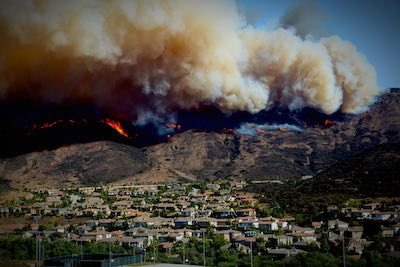
The worst-case scenario—a so-called “Grey Swan” hurricane—would be almost apocalyptically violent. It would sweep up the warm, shallow waters of Tampa Bay, packing winds of up to 200 mph and engulfing a metro area of 2.8 million people in a storm surge of more than 35 feet—twice the level needed to put most of the city underwater.
If this sounds like something out of a Hollywood disaster film, be assured that it has about as much chance of happening as that movie—about .01 percent in any given year, according to an article last summer in Nature Climate Change. But the point of the article by scientists from MIT and Princeton isn’t that such a storm is necessarily imminent; it’s that the odds of it occurring are increasing rapidly, from today’s one in 10,000, to one in 700 by the end of the century.
Moreover, while it’s impossible to completely shield Tampa and other coastal cities from this kind of catastrophe, there is much more they can do to prepare for both a historic Grey Swan hurricane (which, unlike a “Black Swan,” can be predicted) and the storms we are witnessing today—storms that are possibly growing stronger and more destructive as global warming causes ocean temperatures and sea levels to rise.
Countering Resignation—and Denial
The challenge for researchers and disaster managers is to get the public to understand the real risks they encounter and put them in perspective. It is also necessary to do as much as possible to empower the public to act both pre- and post-event. When faced with these scenarios, people often respond with either resignation—how, after all, do you prepare for an apocalypse?—denial, or an understandable urge to put off planning for tomorrow in favor of the pressing needs of today.
“Especially given the current economic situation, people are reluctant to engage in long-term projects that might enhance their resilience,” said Tim Frazier, Faculty Director for the Master's in Emergency & Disaster Management (EDM) master’s program at Georgetown University in Washington, D.C. “They fear they are compromising the present for an event that may or may not occur in the future.”
An expert in human/environment geography, Dr. Frazier works on hazard mitigation planning with Florida communities, including Sarasota, a mere 61 miles south of the much-studied Tampa.
The term “resilience” is central to today’s hazard mitigation planning. It refers to the entire lifecycle of responses: from planning and preparation, to mitigation and recovery. A resilient community must understand the appropriate level of risk and be forward-thinking in its response to these risks.
But facing that reality can be difficult, especially when other needs intervene. Coastal communities are often centers of tourism and engines of economic growth. People depend on them for jobs. Governments rely on them for tax revenue. Add to this the fact that last year’s hurricane season was quieter than normal, that the last strong hurricane to strike Florida (Wilma) was more than 10 years ago, and that memories are continuing to fade.
“So the question becomes, ‘where is the motivation?’,” Dr. Frazier said.
Facing a Growing Threat
Viewed in the long term, the risk of coastal flooding is high, based on recent climate models showing stronger storms and increasingly higher sea levels. Earlier this year, scientists writing in the journal Nature predicted that sea levels would rise nearly twice as much as previously expected, based on recent analysis melting ice in Antarctica. According to the new estimates, if greenhouse gas emissions continue at current levels, the oceans could rise by more than six feet by 2100 and more than 49 feet by 2500.
Even before that correction, an analysis last August by Karen Clark & Company found that the nation’s most vulnerable metropolitan areas could suffer hundreds of billions of dollar in storm surge damage in the event of a 100-year hurricane, defined as an extremely powerful storm (Category 5, with peak winds 160 miles per hour).
Currently, there is a 1 percent chance of such an occurrence in any given year, or about 10 percent over 10 years, but according to an analysis of sea level rise and hurricane storm surge risk conducted by Dr. Frazier, that risk is rising every day.
